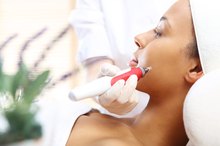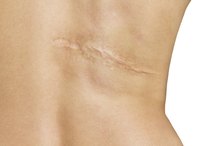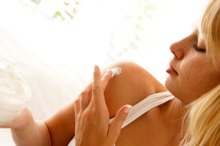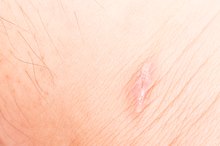What does fact checked mean?
At Healthfully, we strive to deliver objective content that is accurate and up-to-date. Our team periodically reviews articles in order to ensure content quality. The sources cited below consist of evidence from peer-reviewed journals, prominent medical organizations, academic associations, and government data.
- El-Domyati M, et al. (2015). Microneedling therapy for atrophic acne scars: An objective evaluation.
- El-Domyati M, et al. (2015). Microneedling therapy for atrophic acne scars: An objective evaluation.
- Fife D. (2011). Practical evaluation and management of atrophic acne scars: Tips for the general dermatologist.
- Fife D. (2011). Practical evaluation and management of atrophic acne scars: Tips for the general dermatologist.
- Gozali MV, et al. (2015). Effective treatments of atrophic acne scars.
- Gozali MV, et al. (2015). Effective treatments of atrophic acne scars.
- Hession MT, et al. (2015). Atrophic acne scarring: A review of treatment options.
- Hession MT, et al. (2015). Atrophic acne scarring: A review of treatment options.
The information contained on this site is for informational purposes only, and should not be used as a substitute for the advice of a professional health care provider. Please check with the appropriate physician regarding health questions and concerns. Although we strive to deliver accurate and up-to-date information, no guarantee to that effect is made.
Is it Bad When Scars Peel?
**Scarring is a normal result of the skin's healing process from cuts and scrapes 4. As your skin heals, excess collagen collects at the injury site, replacing the lost skin and protecting underlying tissue. Scarring is also susceptible to peeling of the outer skin layers although peeling poses no danger and in some cases is simply a reaction to the healing process.
Causes
During the healing process, you may experience peeling skin from your scar. This is not uncommon as your skin cells constantly shed as new skin cells form. When the shedding becomes noticeable to the naked eye, you could be experiencing normal dry skin. In some cases, people who suffer from eczema or psoriasis experience peeling following a flare up. According to the American Academy of Dermatology, another reason for peeling skin rests on a genetic condition called keratosis pilaris.
- During the healing process, you may experience peeling skin from your scar.
Treatment
How to Use Vaseline to Care for a Scar
Learn More
Medical intervention is required if you notice scaling or signs of lesion formation on your scar, indicating the possibility of eczema or psoriasis. Your dermatologist may prescribe special creams that help combat infection as well as restore moisture to your skin. Scars that peel as a result of normal dryness are best treated with a thick, over-the-counter moisturizer. "The Doctors Book of Home Remedies" recommends taking a daily supplement of vitamin C to aid in scar healing, allowing skin cell turnover to proceed while keeping your skin nourished from the inside out.
- Medical intervention is required if you notice scaling or signs of lesion formation on your scar, indicating the possibility of eczema or psoriasis.
- The Doctors Book of Home Remedies" recommends taking a daily supplement of vitamin C to aid in scar healing, allowing skin cell turnover to proceed while keeping your skin nourished from the inside out.
Dermatologic Reasons
Scars do not always peel for unknown reasons. Some individuals opt for scar revision treatments such as chemical peels, dermabrasion and laser skin resurfacing to reduce scar appearance for cosmetic reasons. According to the American Academy of Dermatology, scar revision treatments possess side effects such as skin peeling at the scar site. This is perfectly normal and will subside within 48 hours of treatment depending on the depth of your scar. It is important to cover your scar with sunscreen when going outdoors while undergoing scar revision treatments.
- Scars do not always peel for unknown reasons.
- Some individuals opt for scar revision treatments such as chemical peels, dermabrasion and laser skin resurfacing to reduce scar appearance for cosmetic reasons.
Misconceptions
Is There Any Way to Get Rid of Scars From Cellulitis?
Learn More
Some common misconceptions include the presence of infection or other bacterial invasion becoming trapped in your scar. This is not necessarily the case when dealing with peeling scars. According to "The Doctors Book of Home Remdies" scars are formed during the healing process and as the skin heals together, bacteria is blocked from the wound. Bacterial invasion is most likely to occur before scar formation occurs while your lesions are still open. Infection is normally accompanied by pain, heat, swelling and leakage of pus and is more likely to occur if you continually pick at your scar, causing the original wound to reopen.
- Some common misconceptions include the presence of infection or other bacterial invasion becoming trapped in your scar.
Considerations
Keloid and hypertrophic scarring is not life threatening; however, when considering treatment it is important to discuss all side effects and expectations with your dermatologist. Over-the-counter chemical peel kits and microdermabrasion treatments are available for at home use however these treatments are not as effective for larger, deeper scarring.
Related Articles
References
- El-Domyati M, et al. (2015). Microneedling therapy for atrophic acne scars: An objective evaluation.
- Fife D. (2011). Practical evaluation and management of atrophic acne scars: Tips for the general dermatologist.
- Gozali MV, et al. (2015). Effective treatments of atrophic acne scars.
- Hession MT, et al. (2015). Atrophic acne scarring: A review of treatment options.
- Logan I, et al. (2015). Subcision.
- Saint-jean M, Khammari A, Jasson F, Nguyen JM, Dréno B. Different cutaneous innate immunity profiles in acne patients with and without atrophic scars. Eur J Dermatol. 2016;26(1):68-74. doi:10.1684/ejd.2015.2713
- Archer CB, Cohen SN, Baron SE. Guidance on the diagnosis and clinical management of acne. Clin Exp Dermatol. 2012;37 Suppl 1:1-6. doi:10.1111/j.1365-2230.2012.04335.x
- Woolery-lloyd H, Kammer JN. Treatment of hyperpigmentation. Semin Cutan Med Surg. 2011;30(3):171-5. doi:10.1016/j.sder.2011.06.004
- Hedelund L, Haak CS, Togsverd-bo K, Bogh MK, Bjerring P, Haedersdal M. Fractional CO2 laser resurfacing for atrophic acne scars: a randomized controlled trial with blinded response evaluation. Lasers Surg Med. 2012;44(6):447-52. doi:10.1002/lsm.22048
- Hedelund L, Moreau KE, Beyer DM, Nymann P, Haedersdal M. Fractional nonablative 1,540-nm laser resurfacing of atrophic acne scars. A randomized controlled trial with blinded response evaluation. Lasers Med Sci. 2010;25(5):749-54. doi:10.1007/s10103-010-0801-1
- Kim EK, Hovsepian RV, Mathew P, Paul MD. Dermabrasion. Clin Plast Surg. 2011;38(3):391-5, v-vi. doi:10.1016/j.cps.2011.05.001
- Wollina U, Goldman A. Fillers for the improvement in acne scars. Clin Cosmet Investig Dermatol. 2015;8:493-9. doi:10.2147/CCID.S86478
- Fabbrocini G, Annunziata MC, D'arco V, et al. Acne scars: pathogenesis, classification and treatment. Dermatol Res Pract. 2010;2010:893080. doi:10.1155/2010/893080
- Alexiades M. "Laser and Light-Based Treatments of Acne and Acne Scarring." Clinics in Dermatology. 2017 Mar - Apr;35(2):183-189.
- Fife D. "Evaluation of Acne Scars: How to Assess Them and What to Tell the Patient." Dermatologic Clinics. 2016 Apr;34(2):207-13.
- Werschler WP, Few JW, Jacob CI, Joseph JH, Spencer JM, Taub AF. "Advancing the Care of Post-Acne Scarring: Expert Insights Into New Treatment Options." Journal of Drugs in Dermatology. 2016 May 1;15(5):518-25.
- Zaleski-Larsen LA, Fabi SG, McGraw T, Taylor M. "Acne Scar Treatment: A Multimodality Approach Tailored to Scar Type." Dermatologic Surgery. 2016 May;42 Suppl 2:S139-49.
- Zouboulis CC, Bettoli V. "Management of Severe Acne." British Journal of Dermatology. 2015 Jul;172 Suppl 1:27-36.
- Shin TM, Bordeaux JS. The role of massage in scar management: a literature review. Dermatol Surg. 2012;38(3):414-23. doi:10.1111/j.1524-4725.2011.02201.x
- Ault P, Plaza A, Paratz J. Scar massage for hypertrophic burns scarring-A systematic review. Burns. 2018;44(1):24-38. doi:10.1016/j.burns.2017.05.006
- Cheatham SW, Lee M, Cain M, Baker R. The efficacy of instrument assisted soft tissue mobilization: a systematic review. J Can Chiropr Assoc. 2016;60(3):200-211.
- Kohata K, Itoh S, Horiuchi N, Yoshioka T, Yamashita K. Influences of osteoarthritis and osteoporosis on the electrical properties of human bones as in vivo electrets produced due to Wolff's law. Biomed Mater Eng. 2017;28(1):65-74. doi:10.3233/BME-171657
- Cheatham, S. Et al. The Efficacy of Instrument Assisted Soft Tissue Mobilization: A Systematic Review. J Can. Chiro, Assoc. 2016 Sep; 60(3): 200-11.
- Kim J, Sung DJ, Lee J. Therapeutic effectiveness of instrument-assisted soft tissue mobilization for soft tissue injury: mechanisms and practical application.Journal of Exercise Rehabilitation. 2017;13(1):12-22. doi:10.12965/jer.1732824.412.
- Kisner, C., & Colby, L. A. Therapeutic exercise: Foundations and techniques. (3 ed.). Philadelphia: FA Davis.
- Shin TM, Bordeaux JS. The Role of Massage in Scar Management: A Literature Review.Dermatologic Surgery. 2012;38(3):414-423. doi:10.1111/j.1524-4725.2011.02201.x.
Writer Bio
Sharin Griffin has been a freelance writer since 2009, specializing in health-related articles. She has worked in the health-care industry as a certified nursing assistant and medical technician. Griffin's medical expertise encompasses bariatrics and geriatric care, with an emphasis on general medicine. She is completing an associate degree in health-care administration from Axia University.









